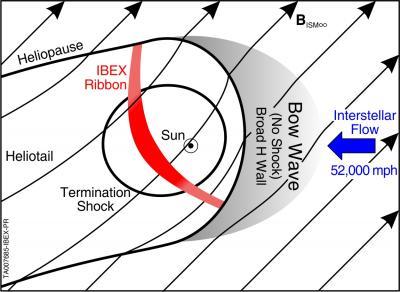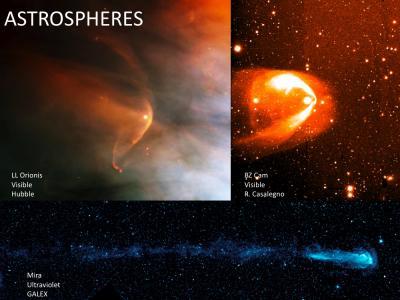New results from NASA's Interstellar Boundary Explorer (IBEX) reveal that the bow shock, widely accepted by researchers to precede the heliosphere as it plows through tenuous gas and dust from the galaxy does not exist.
According to a paper published in the journal Science online, the latest refinements in relative speed and local interstellar magnetic field strengh prevent the heliosphere, the magnetic "bubble" that cocoons Earth and the other planets, from developing a bow shock. The bow shock would consist of ionized gas or plasma that abruptly and discontinuously changes in density in the region of space that lies straight ahead of the heliosphere.
"The sonic boom made by a jet breaking the sound barrier is an earthly example of a bow shock," says Dr. David McComas, principal investigator of the IBEX mission and assistant vice president of the Space Science and Engineering Division at Southwest Research Institute (SwRI). "As the jet reaches supersonic speeds, the air ahead of it can't get out of the way fast enough. Once the aircraft hits the speed of sound, the interaction changes instantaneously, resulting in a shock wave."

New data from the IBEX spacecraft show that the heliospheres lower speed, combined with higher magnetic pressures found in the interstellar medium, prevent the formation of a bow shock, which for decades was thought to form ahead of the heliosphere as it moved through the galaxy. Instead, these factors combine to suggest the heliosphere creates more of a bow wave as it travels through space.
(Photo Credit: Southwest Research Institute)
For about a quarter century, researchers believed that the heliosphere moved through the interstellar medium at a speed fast enough to form a bow shock. IBEX data have shown that the heliosphere actually moves through the local interstellar cloud at about 52,000 miles per hour, roughly 7,000 miles per hour slower than previously thought — slow enough to create more of a bow "wave" than a shock.
"While bow shocks certainly exist ahead of many other stars, we're finding that our Sun's interaction doesn't reach the critical threshold to form a shock, so a wave is a more accurate depiction of what's happening ahead of our heliosphere — much like the wave made by the bow of a boat as it glides through the water," says McComas.
Another influence is the magnetic pressure in the interstellar medium. IBEX data, as well as earlier Voyager observations, show that the magnetic field is stronger in the interstellar medium requiring even faster speeds to produce a bow shock. Combined, both factors now point to the conclusion that a bow shock is highly unlikely.
The IBEX team combined its data with analytical calculations and modeling and simulations to determine the conditions necessary for creating a bow shock. Two independent global models — one from a group in Huntsville, Ala., and another from Moscow — correlated with the analytical findings.
"It's too early to say exactly what this new data means for our heliosphere. Decades of research have explored scenarios that included a bow shock. That research now has to be redone using the latest data," says McComas. "Already, we know there are likely implications for how galactic cosmic rays propagate around and enter the solar system, which is relevant for human space travel."

Bow shocks exist around other astrospheres, as seen in these images taken by multiple telescopes. New IBEX data show that our heliosphere moves through interstellar space too slowly to produce a bow shock, creating more of a wake as it travels through space.
(Photo Credit: NASA/ESA/JPL-Caltech/Goddard/SwRI)
Source: Southwest Research Institute